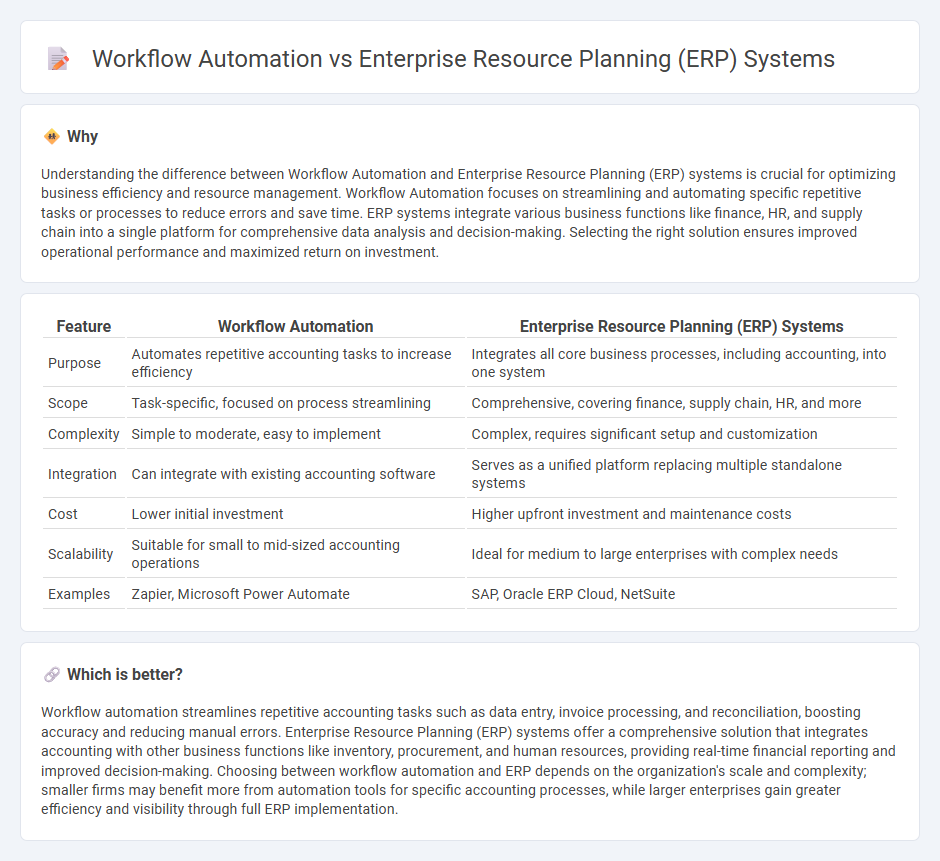
Workflow automation streamlines repetitive accounting tasks by integrating software tools that enhance efficiency and reduce errors, while Enterprise Resource Planning (ERP) systems provide comprehensive financial management by unifying core business processes, including accounting, procurement, and inventory. ERP systems offer real-time data analytics and reporting capabilities essential for strategic decision-making, whereas workflow automation targets specific process improvements within those systems. Explore how combining workflow automation with ERP systems can transform your accounting operations and drive business growth.
Why it is important
Understanding the difference between Workflow Automation and Enterprise Resource Planning (ERP) systems is crucial for optimizing business efficiency and resource management. Workflow Automation focuses on streamlining and automating specific repetitive tasks or processes to reduce errors and save time. ERP systems integrate various business functions like finance, HR, and supply chain into a single platform for comprehensive data analysis and decision-making. Selecting the right solution ensures improved operational performance and maximized return on investment.
Comparison Table
| Feature | Workflow Automation | Enterprise Resource Planning (ERP) Systems |
|---|---|---|
| Purpose | Automates repetitive accounting tasks to increase efficiency | Integrates all core business processes, including accounting, into one system |
| Scope | Task-specific, focused on process streamlining | Comprehensive, covering finance, supply chain, HR, and more |
| Complexity | Simple to moderate, easy to implement | Complex, requires significant setup and customization |
| Integration | Can integrate with existing accounting software | Serves as a unified platform replacing multiple standalone systems |
| Cost | Lower initial investment | Higher upfront investment and maintenance costs |
| Scalability | Suitable for small to mid-sized accounting operations | Ideal for medium to large enterprises with complex needs |
| Examples | Zapier, Microsoft Power Automate | SAP, Oracle ERP Cloud, NetSuite |
Which is better?
Workflow automation streamlines repetitive accounting tasks such as data entry, invoice processing, and reconciliation, boosting accuracy and reducing manual errors. Enterprise Resource Planning (ERP) systems offer a comprehensive solution that integrates accounting with other business functions like inventory, procurement, and human resources, providing real-time financial reporting and improved decision-making. Choosing between workflow automation and ERP depends on the organization's scale and complexity; smaller firms may benefit more from automation tools for specific accounting processes, while larger enterprises gain greater efficiency and visibility through full ERP implementation.
Connection
Workflow automation enhances Enterprise Resource Planning (ERP) systems by streamlining repetitive accounting tasks such as invoice processing, expense tracking, and financial reporting. Integrating workflow automation with ERP systems improves data accuracy, accelerates transaction cycles, and ensures regulatory compliance through standardized financial processes. This synergy supports real-time visibility into accounting operations, enabling better decision-making and resource allocation.
Key Terms
Integration
Enterprise Resource Planning (ERP) systems centralize business processes by integrating core functions like finance, supply chain, and human resources into a unified platform, enhancing data consistency and operational visibility. Workflow automation optimizes specific tasks and routine processes by automating step-by-step operations across various applications, improving efficiency and reducing human error. Explore how combining ERP systems with workflow automation can create seamless integration and drive digital transformation in your organization.
Process Efficiency
Enterprise Resource Planning (ERP) systems integrate core business processes like finance, supply chain, and human resources into a unified platform to enhance overall organizational efficiency. Workflow automation specifically targets repetitive tasks and process workflows, reducing manual intervention and accelerating operations within departments. Discover how combining ERP and workflow automation can maximize process efficiency in your enterprise.
Real-time Data
ERP systems integrate core business processes to provide a centralized platform for real-time data access, enhancing decision-making across finance, supply chain, and human resources. Workflow automation streamlines specific tasks and processes, enabling instantaneous data updates and reducing manual errors within designated workflows. Explore how leveraging real-time data through ERP and workflow automation can transform operational efficiency and business agility.
Source and External Links
Enterprise Resource Planning - ERP systems manage and integrate business processes, utilizing real-time data and technology to streamline operations across various departments.
What is Enterprise Resource Planning (ERP)? - This webpage explains ERP as a system that comes in different deployment models, including cloud, on-premises, and hybrid, to manage business functions and workflows.
What is ERP? A Breakdown to Enterprise Resource Planning - It provides an overview of ERP systems as software that centralizes backend processes, automates workflows, and drives operational improvements by integrating data across departments.
 dowidth.com
dowidth.com